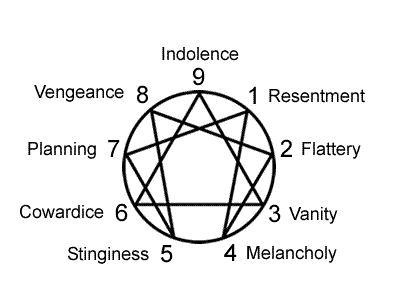Enneagram Fixations: Nine habits of ego mind that limit us

When you hear someone talk about a person's Enneagram fixation, or "fix" for short, they're either talking about one of the nine Enneagram personality types in general or more specifically about the ego fixation of their Enneagram type.
The ego fixations of the Enneagram types originated with Oscar Ichazo's ego-types and referred to the intellectual part of the ego. With the personality types of today, the ego fixation represents a habit of mind that goes along with a particular Enneagram type.
The more habituated a person is within a given fixation the more fixated or stuck the person is within their Enneagram type. The fixation can narrow a person's focus to only that way of seeing things. This narrowing then limits a person's ability to take in alternative ways of interpreting and responding to situations.
One goal with the personality types is to loosen the grip of this fixation so that the individual can be more flexible and adaptable in the way they deal with situations. This also opens the individual up to exploring other ways of approaching life as represented by other Enneagram types besides their own.
Ichazo's original ego fixations
Oscar Ichazo identified nine ego-types, with each one represented by a different number on the Enneagram symbol. Each ego-type was associated with a particular fixation. Work on ego reduction began by first identifying an individual's fixation or ego dominated thought.
Taken from a book called Transpersonal Psychologies edited by Charles T. Tart, the descriptions of the ego fixations below come from John C. Lilly and Joseph E. Hart who attended the 1970 Arica retreat led by Oscar Ichazo.
- Resentment - Always angry with himself and others for not being perfect.
- Flattery - Needs an approving audience.
- Vanity - Strives for degrees, positions of importance, power over others.
- Melancholy - Never happy with the present, always looking toward a happy future.
- Stinginess - Desires anonymity and to view life from the sidelines.
- Cowardice - Needs a strong leader to follow; one who can be protective.
- Planning - Always planning what to do and what must happen; always disappointed at the outcome.
- Vengeance - Destructive of self and others out of a sense of injustice.
- Indolence - This person seeks love outside himself and makes no effort to find his essence and peace.
The ego fixations and today's personality types
Athough Ichazo's names for the ego fixations are still used today, the meanings need to be reinterpreted to more closely match today's personality types. The descriptions below are one such interpretation.
Type 1: Resentment comes from trying to live up to standards for what's acceptable and right while others aren't.
Type 2: Flattery comes from praising and giving to others in order to connect to them and be liked or gain favor.
Type 3: Vanity comes from gaining a sense of value through accomplishments and subsequent recognition.
Type 4: Melancholy comes from a dissatisfaction with what is and a longing for what once was or could've been.
Type 5: Stinginess comes from holding on to resources in a world that seems to take more than it gives back.
Type 6: Cowardice comes from waiting for something or someone to alleviate doubt before taking action.
Type 7: Planning is about looking forward to many exciting possibilities and a way to fit them all into one's life.
Type 8: Vengeance comes from balancing the scales of justice when others attempt to take unfair advantage.
Type 9: Indolence is about resisting demands and expectations that disrupt a feeling of harmony and continuity.
Click here for the Complete Guide to the Enneagram.
This free guide explains- the nine Enneagram personality types
- the many type variations within type
- where the types came from (origins and history)
- how the types use the Enneagram symbol
Click here for Enneagram tests.
These free tests help you find your- primary type
- candidate types
- preferred wing
- intinctual subtype
- instinctual variant stacking
- center types (gut, heart, and head)
- tri-center with wings